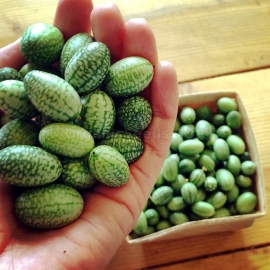 EXCLUSIVE
EXCLUSIVE








Organic Cucamelon Seeds (Melothria scabra)
3.00 €
Is it an exceptionally small cucumber or the world’s cutest watermelon? That is the vexing question. Melothria scabra, known as Cucamelon or Mouse melon is a tiny melon that has been creating a buzz in the farmer’s markets.
-
Organic Cucamelon
Is it an exceptionally small cucumber or the world’s cutest watermelon? That is the vexing question. Melothria scabra, known as Cucamelon or Mouse melon is a tiny melon that has been creating a buzz in the farmer’s markets.
The fruits are small enough to fit into a teaspoon, yet bite into one and the flavour is pure cucumber with a refreshing tinge of lime. Its unique flavour, its pest-free and rampant habit of growth, not to mention its huge productivity, all conspire to recommend this unusual vine to home gardeners looking for something new to add to their menus.
These tiny watermelon look-a-likes from Central America have been popular since Aztec times. The vines produce a constant stream of fruit throughout the summer, known as Sandiita or 'little watermelon' in Spanish. Despite their exotic origins and adorable appearance, they are much easier to grow than regular cucumbers. Their lush vines are ignored by pests, resistant to drought and perfectly happy to grow outdoors if given a sheltered sunny site. The vine is attractive and productive enough for hanging baskets. Sow in April to May for harvesting July to September.
Cucamelons can be eaten in exactly the same way as traditional cucumbers - sliced into salads, chopped into salsas or pickled whole like cornichons. Mix whole cucamelons (fresh, blanched or pickled) into a bowl of olives and serve with drinks, or why not go the whole way and spear them with toothpicks and pop them in a martini.
The flavour has been described as 'Cucumber with a bit of watermelon rind and a squeeze of lemon or lime'. This tiny treasure can match the crunch of pretzels and chips. They are terrific in stir-fries; can be pickled just like French gherkins, eaten raw in salads or pickled. They also can be chopped and added to salsas for extra texture and flavour. A conversation piece in the garden, or as an edible centerpiece at the table.
The Cucamelon plant grows to around 10cm to 15cm (4 to 6in) wide and 1.2m to 1.5m (40 to 50in) tall. It can be treated like a perennial providing you with fruit year-after-year. In late autumn once the fruiting period is over, lift the cucamelon's main radish like root and store in barely moist compost in a garage or shed over winter. Plant out again in early April to achieve early fruiting.
Growing Cucamelons:
Growing cucamelons is no hassle at all. Simply start them indoors the same time you would begin seedlings for cucumbers, and plant them outdoors at exactly the same time. In fact, cucamelons are a little more cool-weather tolerant than most cucumbers, which is an added bonus should you get a late cold spell. The plants are also fairly drought-resistant, more so than cucumbers, they don’t need the cover of a greenhouse, fancy pruning or training techniques and suffer from very few pests.
The plants make pretty, high-yielding vines that can be planted really close together to get the most out of a small space, as little as 15cm (6in) between plants around a trellis. Cucamelons are also fine to grow indoors as long as they get enough light and heat, for example in a conservatory or by a bright windowsill in a warm living room.
Also known as: Mouse Melon, Mexican Sour Gherkin, Cucamelon, Mexican Miniature Watermelon, Mexican Sour Cucumber and Pepquinos.
